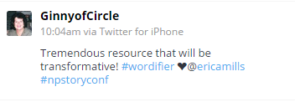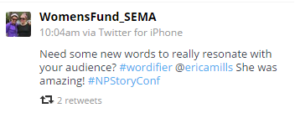 [This is part nine of our 1, 2, 3 Marketing Tree Step-by-Step series, written by our fabulous intern, Vicki. If you’re new to the series, you can catch up on previous posts. If you haven’t already gotten a 1, 2, 3 Marketing Tree, now is a great time to either buy the awesome poster-size version or download the free version, so you can follow along. You can find the free version in Claxon’s DIY tools a la carte menu or in the Marketing 101 Toolkit. You can buy the super spiffy poster here.]
[This is part nine of our 1, 2, 3 Marketing Tree Step-by-Step series, written by our fabulous intern, Vicki. If you’re new to the series, you can catch up on previous posts. If you haven’t already gotten a 1, 2, 3 Marketing Tree, now is a great time to either buy the awesome poster-size version or download the free version, so you can follow along. You can find the free version in Claxon’s DIY tools a la carte menu or in the Marketing 101 Toolkit. You can buy the super spiffy poster here.]
Last week we discussed your supporters. This week, we are going to wade into murky waters and discuss people who aren’t your supporters. What do you do when you want to reach people who aren’t like your current supporters? Ask yourself if you really do need to reach them and then think long and hard about your answer.
There are three basic cases where you might be thinking of reaching outside of your current sphere.
Case #1: You need to reach a new demographic.
First, make sure you are clear on why you need this new demographic. Is it a good reason? Is it connected to the purpose and strategy of your organization? You will have to work harder to get a new type of supporter. Will the return be worth the investment? Notice the difference between, “We need more Spanish speaking volunteers because so many of our clients speak only Spanish” and “We need a lesbian on our board to improve diversity.” (True story.)
Second, be realistic. If you can target a new demographic that is only a bit of a shift, that’s going to be much easier for you.
Then, research. Lots of research. It is always hard to get out of your own head and look at things from another’s perspective. It’s a much harder task when you don’t have a lot of experience with the other person.
Case #2: You want to raise public awareness.
Don’t do this.
Seriously, don’t. The general public is too broad and vague a target. Be specific. The more focused your efforts are, the more effective you will be. Even if you need to eventually get your message to as broad an audience as possible, break it up into smaller steps.
Approach this as in Case #1. What is a new demographic that shares some characteristics with current supporters? Who could help connect you with a broader audience as you continue to expand your demographic reach in the future?
Erica uses an example of a campaign to stop texting while driving and objects that this isn’t about general awareness, it is about stopping people from texting. I’ll add to that objection that the target isn’t everyone, it is people who text while driving.
When you get to how you are going to reach your targets, you may find that it is more effort than it is worth to differentiate your target from the general public, but that question comes later. You aren’t doing yourself any favors to assume you won’t be able to differentiate or to forget who your real target is.
Case #3: You want to reach opponents.
Caution! Do you need to do this? If not, this is a waste of your precious time.
Usually you don’t actually need to do this. But, some people, not nearly as clever you, get sucked into trying to woo people who just aren’t interested. Their cause is so important that they just can’t imagine how anyone could not support it.
Anytime you see something weird, your brain is drawn to it. At Claxon, we like to talk about how you can use that fact to improve your messaging by making sure your words are interesting. But, don’t let that same tendency be your own downfall. Yes, I know it is super weird that someone wouldn’t believe in what you are doing, but let it go.
If you are struggling with this, Claxon has a handy tool called the Belief-o-Meter that helps you figure out who you should be focusing on and who you should leave alone.
There are rare cases where you do need to convert the opposition. This is usually because your strategy requires support from a significant percentage of the population as with advocacy campaigns or boycotts. If this is you, take everything I said about case #1 and amplify it. Do even more research. Be even more realistic. If you just need someone to not oppose you, be satisfied with that. Don’t expect them to become donors. And, then do some more research.
An interesting, headline grabbing example is same-sex marriage. Freedom to Marry’s goal is to end the exclusion of same-sex couples from marriage. They are changing hearts across the nation so that the US Supreme Court will feel comfortable ruling in favor of marriage equality. To do this, they need to reach the opposition.
Why do they talk about freedom to marry instead of marriage equality? Because their opposition responds more favorably to the phrase “freedom to marry.” They know this because they did lots and lots of research. And it’s working. After state campaigns started using their research, in 2012 the general populations of not one, but four states, became the first to vote in favor of freedom to marry.
Freedom to Marry has put in a lot of hard work, resources, and research time. And they have been realistic. They are asking people who have opposed them to change how the respond to polls, not expecting new donors. The investment required to reach the opposition has been enormous, but it is necessary for their mission and strategy.
Example: Chirp
Chirp, the school for birds founded by Claxon’s mascot, Roxie, needs to reach a new demographic. (Check out previous posts for the full back-story.)
After surveying their students, they learned that there was more interest in social mixing between different flocks than they had thought. This was very encouraging, but they also came to a concerning realization. All of their current students are birds that tend to flock. They want to reach all birds, but what about solitary birds? Could these birds be reached? Difficult decisions needed to be made. The leadership of Chirp decided to be realistic about their ability to grow into such a different market space. For this year’s marketing campaign they will target new types of flocking birds.
More research is needed before they can understand the needs and interests of their more solitary brethren. Owls typically roost alone or as a pair. However, they do occasionally flock and so are a good target audience for Chirp’s next phase of expansion. Albert the Owl has agreed to lead research efforts and will be traveling to the next parliament. (Don’t you just adore collective nouns?)
In sum…
Before you try to reach beyond your supporters, make sure you really do need to and be prepared for it to take extra effort. Next time we will be back to talking about supporters as we describe your ideal one and develop personas.
 I recently read Brene Brown’s book, Daring Greatly: How the Courage to Be Vulnerable Transforms the Way We Live, Love, Parent, and Lead.
I recently read Brene Brown’s book, Daring Greatly: How the Courage to Be Vulnerable Transforms the Way We Live, Love, Parent, and Lead.
 Support. Give. Donate. Which one is best for year-end fundraising (including #GivingTuesday)?
Support. Give. Donate. Which one is best for year-end fundraising (including #GivingTuesday)?








 [This is part six of our 1, 2, 3 Marketing Tree Step-by-Step series, written by our fabulous intern,
[This is part six of our 1, 2, 3 Marketing Tree Step-by-Step series, written by our fabulous intern, 
 [This is part five of our 1, 2, 3 Marketing Tree Step-by-Step series, written by our fabulous intern,
[This is part five of our 1, 2, 3 Marketing Tree Step-by-Step series, written by our fabulous intern, 
